A Long Time Ago... #13
Hello there.
Welcome to the thirteenth of these posts exploring art, fiction and history. Every other Sunday I share some insights into my two major passions - Star Wars and history, or specifically, ancient art.
Art as a means of representation, observation and meaning, has survived tens of thousands of years, expressed now in a mesmerising multitude of ways. I'm fascinated by its origins, and a particular subgenre of art known as the Star Wars franchise - these two interests combined for my first Star Wars Insider article ART WARS, found in issue #226.
Now I’m expressing and sharing this fascination by taking you in timeline order through Marvel’s 2015-onwards Star Wars comics, as well as the usual ancient art sites that have inspired my writing.
In A Galaxy Far, Far Away…

That’s a view of the many folders of single issue and trade paperback Star Wars comics from Marvel since 2015 in my collection, nearly all of the Skywalker saga stories, including some variants! But since photographing my storage system in detail, and breaking down each issue or paperback would take a long time, I’m going to just share a brief chronological reading order in two parts starting with this newsletter and finishing in #14.
‘Brief’, so I won’t be naming the many many talented creators, or explain the back and forths and overlappings between the longer ongoing series (there are way better and more comprehensive lists - that even go panel by panel!).
Mace Windu (four issues) follows the titular Jedi on an adventure before he’s even on the Jedi Council.
Darth Maul (five issues) pulls in other characters from the prequel time period, seeing the Sith apprentice in hiding, training for the day he and his master will reveal themselves.
Darth Maul - Black, White and Red (four issues) is an anthology series around this whole pre-Episode I time period, giving us more of the fearsome and iconic dark sider in just those three colours as part of Marvel’s Black, White and Blood line.
Jango Fett (four issues) follows the bounty hunter on a new mission in his prime, just before the events of Episode I, and featuring other well-known hunters.
The Phantom Menace 25th Anniversary Special is a one-shot directly tying into the film and giving more depth to this time period, because then we jump ahead.
Obi-Wan and Anakin (five issues) is one of a few unique stories that takes place in the decade between Episodes I and II, where Anakin grows from 9 to 19, giving us rare insight into his development and training with his master.
Mace Windu - Jedi of the Republic (five issues) follows on from the aftermath of Episode II as (as Yoda says) “Begun, the Clone Wars have.” and the Jedi become generals of an army instead of peacekeepers.
Darth Maul - Son of Dathomir (four issues, originally by Dark Horse) adapts a four-part arc from the other end of the Clone Wars which was never fully realised in animation, making it an invaluable part of the Star Wars tapestry that shows how the Sith escaped custody and retook his throne in between seasons five and seven of The Clone Wars.
Darth Vader: Dark Lord of the Sith (twenty-five issues and an annual (Darth Vader: Annual 2)) is another unmissable series, and our first major ongoing, following said Dark Lord from the moment he takes his first breaths in his suit to setting up the Inquisitors, to when he presides over an impressive fortress on Mustafar.
Jedi Fallen Order - Dark Temple (five issues) is a tie-in to the video game Jedi Fallen Order, mainly a prequel story following two of the game’s Jedi characters but with a frame story at the time of the game.
Inquisitors (four issues) is a miniseries that’s yet to fully be released, following the Jedi hunters on a mission that’s finally a dedicated story to their evilness.
Han Solo - Imperial Cadet (five issues) does what it says on the tin, showing us that gap in Han’s story only briefly seen in the film Solo, whilst also introducing Beilert Vallance, a character of great importance later.
Beckett (one-shot) lets us spend more time with Woody Harrelson’s character from the film Solo.
Lando - Double or Nothing (five issues) is also set just prior to Solo, following young Lando and L3-37 while the Millennium Falcon is under their ownership.
Han Solo and Chewbacca (ten issues) then moves us beyond the events of Solo, adding a lot more depth to the character that’s looking more like Harrison Ford now, exploring what he and Chewie were doing in the decade before Episode IV.
Kanan (twelve issues) originally held the subtitle The Last Padawan when it first came out as a tie in to Rebels’ first season (though that would be misnomer now) showing the young Jedi’s time during the Clone Wars, his experience of Order 66 and his early adventures in its aftermath, within a frame story.
Thrawn (six issues) adapts the novel I wrote about in #5 of these posts, followed by Thrawn Alliances (four issues), adapting most of the second novel following the Chiss Imperial.
Vader - Dark Visions (five issues) is a series of legends about the character, similar to the Luke short story collection I wrote about in #8 but much more visually impactful with nightmare - or dream- renditions of Vader.
Rogue One - Cassian and K-2SO (one-shot) explores the meeting of the beloved rebel spy and reprogrammed droid from the film, but we’ll have to see if the show Andor will contradict or retell these events.
Target Vader (six issues) continues Valance’s story after the events of his Imperial training as a cyborg bounty hunter working with and against others trying to claim their very dangerous prize.
Obi-Wan (five issues) sees the wizened old master recounting tales from childhood to the present day in his journals, ready for Luke, which brings us up to Episode IV.
Princess Leia (five issues) picks up in the moments after the medal ceremony, and features Leia, princess of a destroyed planet, coming to terms with that and trying to protect and reconnect any Alderaanian survivors.
Chewbacca (five issues) lets us finally see that Chewie got a medal too, following the lovable Wookie on a touching journey, impressively maintaining his dialogue and continuing his story at this early nebulous time when he and Han still aren’t really rebels.
Lando (five issues) features the soon-to-be baron of Cloud City and his friend Lobot on a mission to steal an Imperial pleasure yacht, with surprising ties to Dark Lord of the Sith and the latest main Star Wars run.
Han Solo (five issues) was the last of the character-focussed miniseries after Episode IV, seeing the titular character reunited with Chewie and roped into rebelling via a starship race.
Star Wars (seventy-five issues and four annuals (one of which, Annual 4, takes place before the rest of the series)) was the flagship title for years, filling in the adventures of the main characters in the rest of the three years between Episodes IV and V with a whole host of amazing arcs and crossovers.
Darth Vader (twenty-five issues and an annual) is probably required reading as not only does it show Vader’s realisation about his son, but introduces Doctor Aphra and also crosses over with the main series in an incredible Vader Down event.
Doctor Aphra (forty issues and three annuals) continues the adventures of the rogue archaeologist and the other fantastic side characters from the Vader series, pushing them to new heights, and also crossing over with the main Star Wars series in the Screaming Citadel event.
The Last Jedi - Storms of Crait is a one-shot set sometime amidst the main Star Wars run before the issues numbering in the 50s, when the Rebellion is looking for new bases and will eventually settle on Hoth, rejecting the base on Crait that Leia would rely on decades later in Episode VII.
Empire Ascendant (one-shot) features four stories serving as epilogues to the three main series, yet also as prologues for the relaunches that fill in the gap between Episodes V and VI that we’ll get to next time, including Bounty Hunters.
Yoda (ten issues) is the final series before Episode V though, similar to the Obi-Wan series with the Jedi reminiscing the stages of his long life in three three-issue arcs, with a final issue that ties it all together and sets the stage once again for Luke’s arrival.
In Creswell, Derbyshire, England…
This is actually the first of these sites that I’ve visited in person, no Google maps or recreation. There, a wonderful tour (hardhats included), took us around the site but mainly stopped in Church Hole Cave which houses the vast majority of prehistoric art.
Before that, though, there’s the brilliant little museum in the site’s visitor centre which hosts animal skeletons from up to 120,000 years ago, from hippo fragments to a rare near-complete Ice Age baby hyena, as well as hyena droppings, other bones and the bones of other animals gnawed by them in cave dens. But there’s also evidence of woolly rhinos, mammoths, lions, bears, horses, reindeer, bison, wolves, an artic fox, lemming, pika, even some fish scales. These animals didn’t exist here at the same time, of course. A lot changed and shifted in those 120,000 years, including the vast sheets of ice that kept our ancestors at bay.
Neanderthals reached the caves in Creswell’s gorge around 50,000 years ago, better adapted to the cold. It was 22,000 years later when homo sapiens arrived on the scene, but only around 13,000 years ago, when the ice retreated again, that all the art was made, dated to the Upper Palaeolithic by flowstone on the walls.
But art was not just on the cave surface. The museum also held an amber pebble brought to the site for some purpose, as well as a representation of some humanoid figure that’s unique in Britain. Sadly the woolly rhino bone it was etched on was with the British Museum at the time, but it was still interesting to learn that the drawing was done on a bone 10,000 years old at the time.
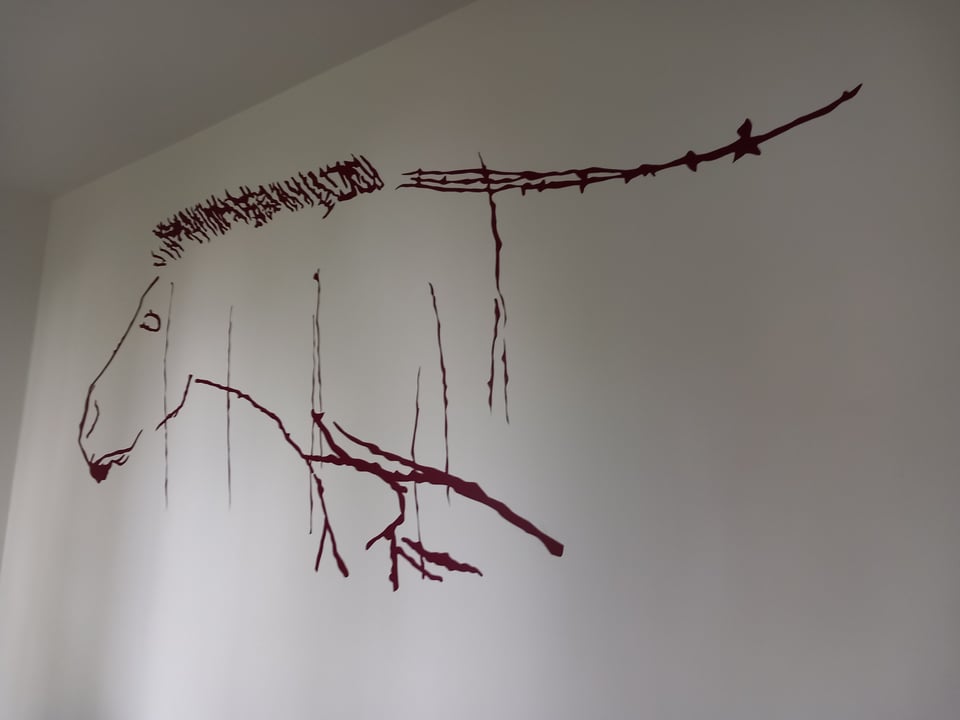
There was also a recreation of what probably isn’t anymore the oldest known coloured drawing in Britain, a horse that had been skilfully etched again on a small bone but this time coloured with ochre. And there were also many tools from the oldest of Neanderthal hand axe to a bone needle, almost 40,000 years apart. Creswellian is even the name used for a certain UK culture and flint point type.
But now to the site itself…
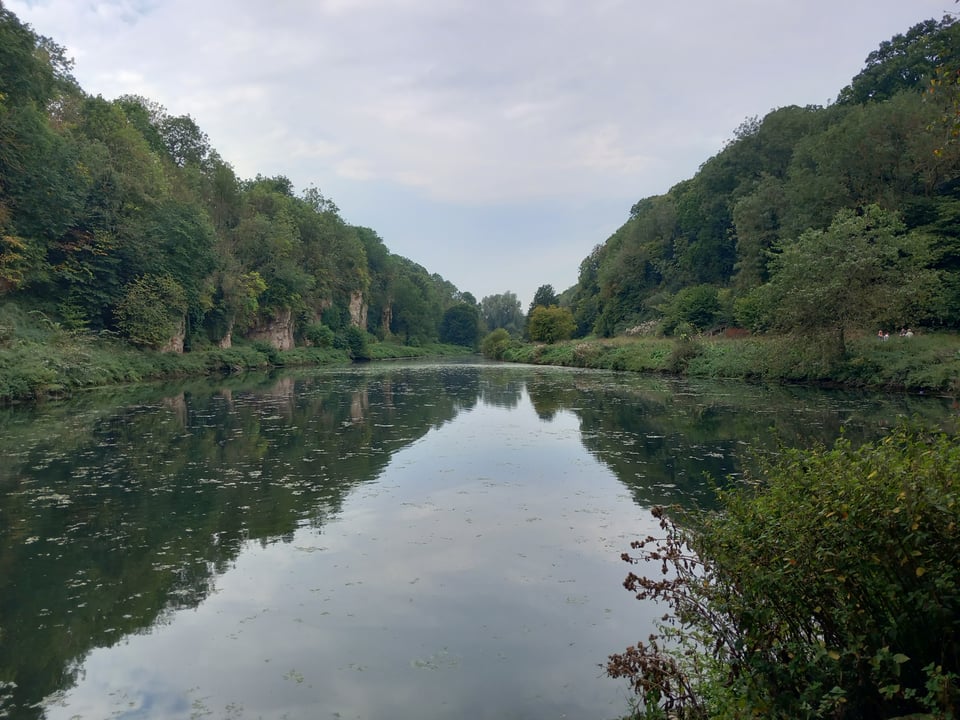
The first British ice age rock art was found here, amidst the many caves on either side, based on a hunch and also by accident, in 2003.
The thing was, at the time the art was made, the artists would’ve had to face upwards, crawling on a floor which is now metres lower, and the cave entrance was 4-5m further forwards. To see it now you have to stand on a tall platform. It also would’ve been so much colder than today, -10 degrees in summer, and if you stood on the gorge and looked north, you’d probably see the 2km tall wall of ice in the distance. So it would’ve all looked so different from the barred off wide dark space seen today. You’d be hard-pressed to find the art without a guide with a laser pointer (well, you wouldn’t get in). Even with a guide the etchings were hard to see, apart from the ibis, a form of bas-relief with its beak based on an existing contour.
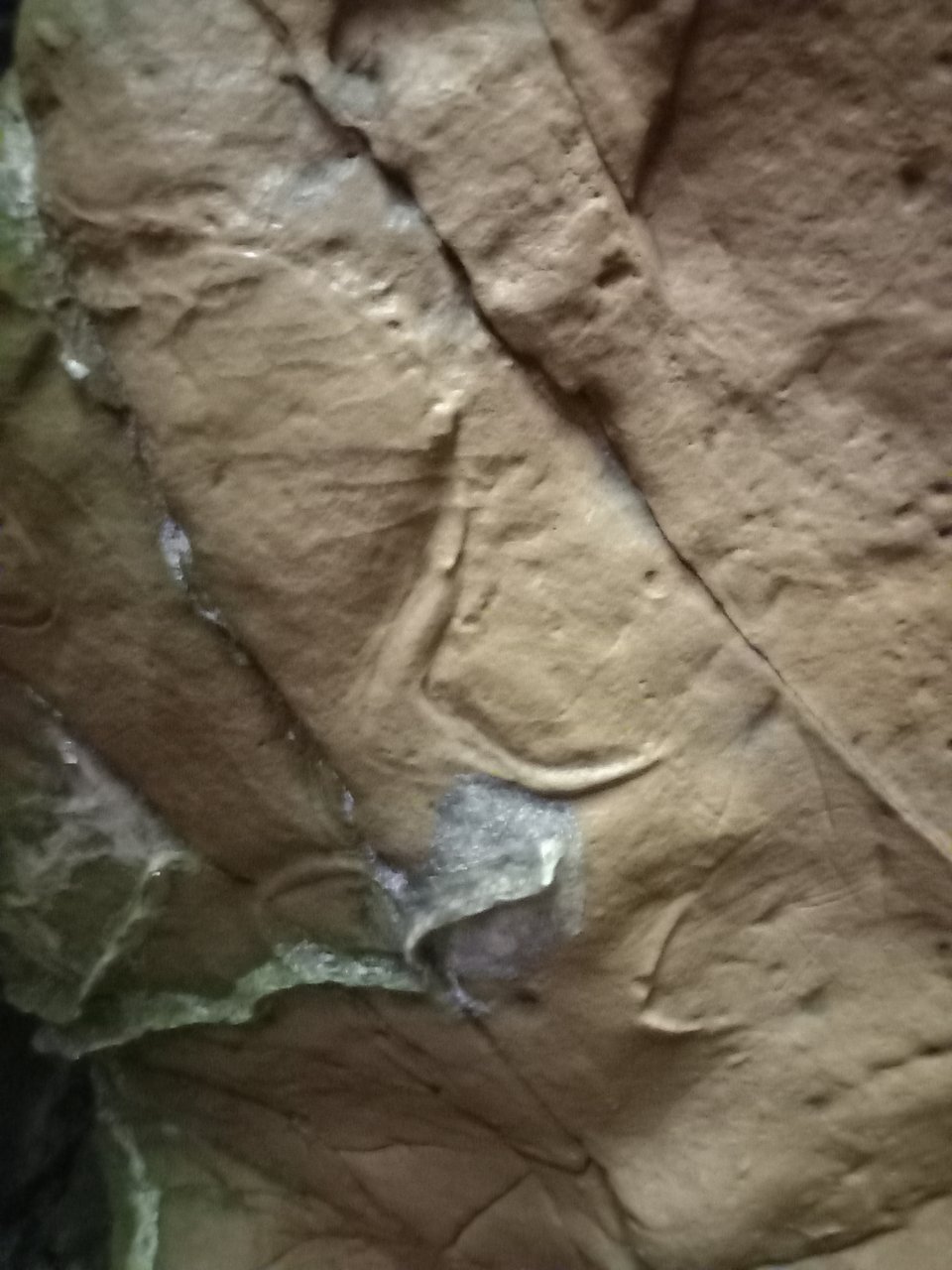
Its beak was probably a worm track in the limestone. The interesting thing is that the birds weren’t around when the art was made, so perhaps someone saw the contour and was reminded of the birds they saw in the south of France or further south. Maybe they were homesick. There are more potential wading birds in the back of the cave.
Two distinct abstract forms have been interpreted as women’s bodies or bird heads. I had a hard time seeing either at the time. My contact in the field who provided quotes for my Insider article, friend and potential colleague in the future, Dr. George Nash, sees one head as a goose/duck, and the other more of a red deer neck and head. Anyway, here’s a full antlered deer:
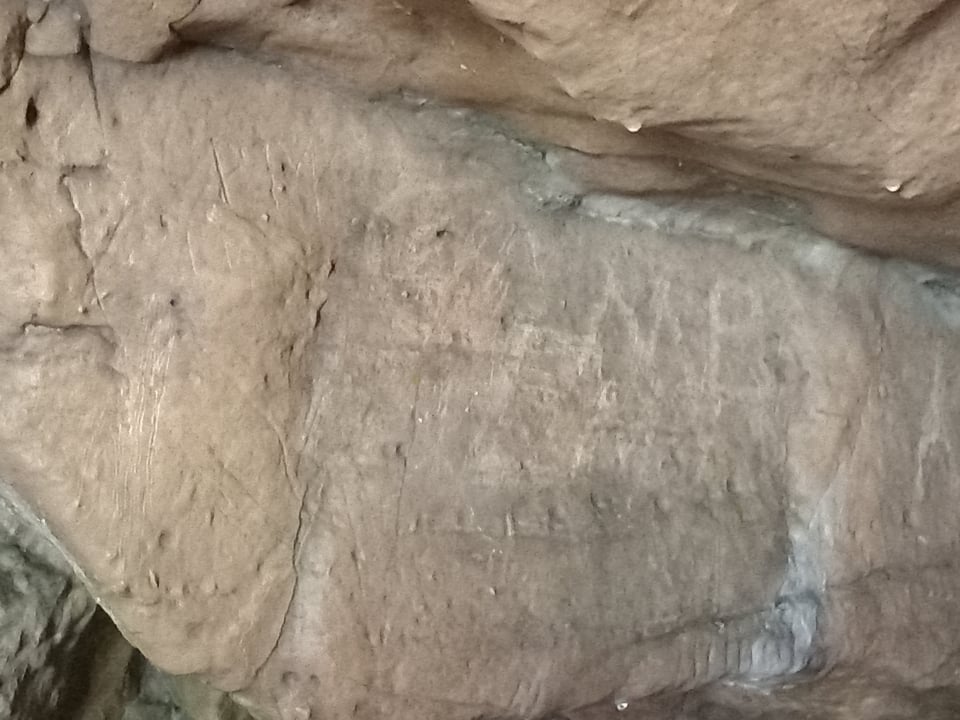
I think it’s good to try and get you to make out these etchings by yourselves. The easiest parts to see in my photo is the head in the upper left, anchored by an eye and much more recent beard graffiti to make the creature into a goat. Triangular legs are also visible. (There are actually quite a few forms overlapping above, including a deer of similar size and many smaller heads.)
There are also a few notches and V shapes around the cave, but below is the other major animal, a bison. No help on this one besides look up from the light!
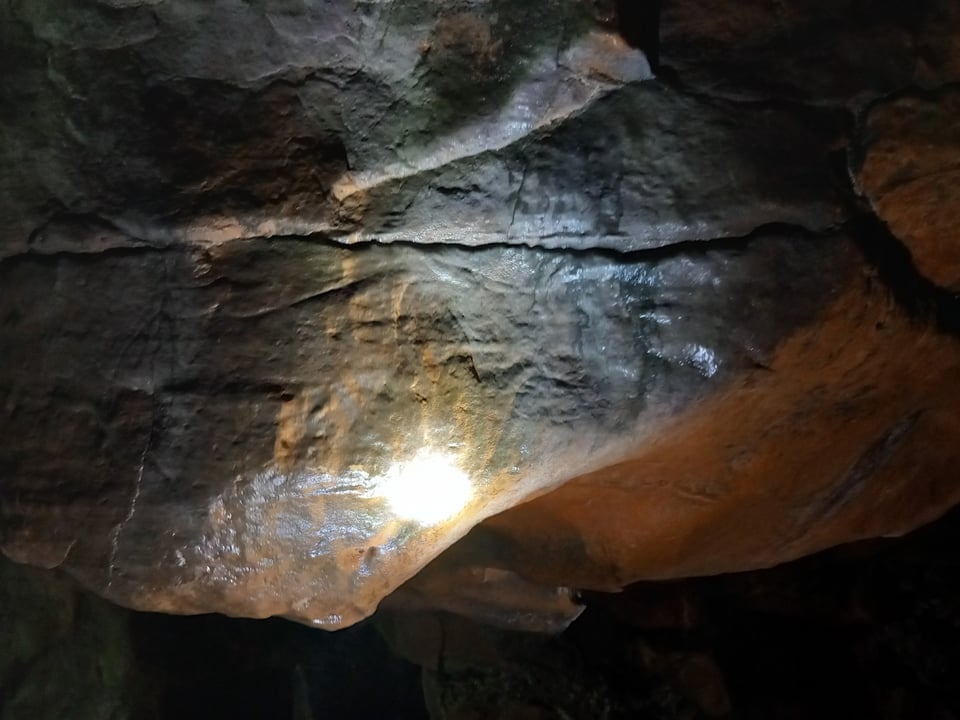
Excitingly, Dr Nash has more recently found eight panels with potential for painted art, including the bison that would’ve been a similar red to famous specimens from France and Spain. And the deer may have had painted geometric forms within its body, or rather, within and around the other overlapping images. And beneath the two necks I mentioned, there’s a series of dots and curves, and two painted circles can be seen actually with the naked eye at the back left of the cave.
I say naked eye because it’s the amazing DStretch technology that brings out all the art. If you’re at all interested in seeing some incredible painted rock art, revelations for the UK’s major public site, check out this video with Dr Nash uploaded by the Bradshaw Foundation. You’ll see the necks I mentioned, get some great imagery of the site from above and within the caves where I couldn’t go - and please stay until the end to see the painted work the DStretch revealed.
There’s a lot more I could tell you about Creswell (all its history since the Ice Age!) Here’s a virtual tour of the main cave, with lots more to explore on Creswell Crag’s site - nothing beats visiting the gorge and going on a tour, though. I still have two books from my visit to pore through before writing my short story based there, but for now we’ve reached the end of this exploration of a long time ago.
I hope you enjoyed! I really appreciate the opportunity to share these two facets of my reading/writing life. Hopefully this series will continue in an exciting new direction soon. Thank you for supporting me on this endeavour!
Harvey
